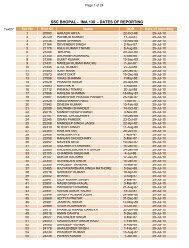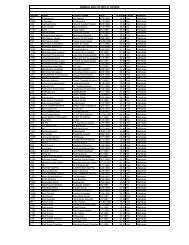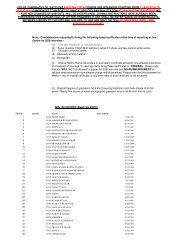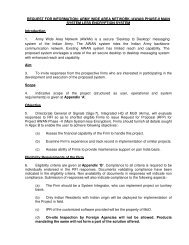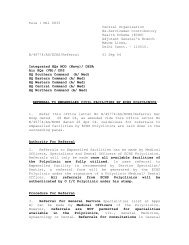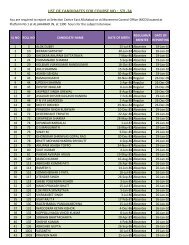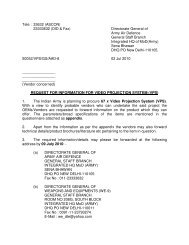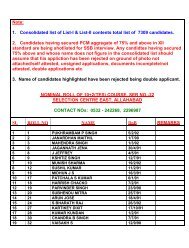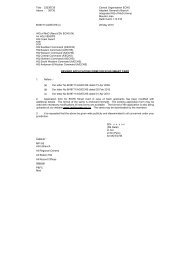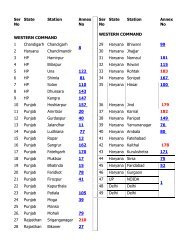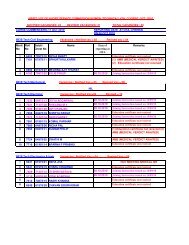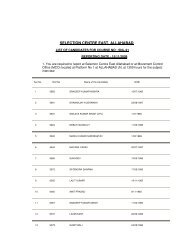Pleural effusion: diagnosis, management and disposal - Indian Army
Pleural effusion: diagnosis, management and disposal - Indian Army
Pleural effusion: diagnosis, management and disposal - Indian Army
You also want an ePaper? Increase the reach of your titles
YUMPU automatically turns print PDFs into web optimized ePapers that Google loves.
PLEURAL EFFUSION: DIAGNOSIS, MANAGEMENT AND DISPOSAL<br />
1. This replaces the DGAFMS Medical Memor<strong>and</strong>um No.63 on Primary<br />
(Idiopathic) <strong>Pleural</strong> Effusion, which dealt with tubercular pleural<br />
<strong>effusion</strong>.<br />
2. Normally the pleural space has 5 to 15 ml of fluid, which acts<br />
as a coupling system between the lung <strong>and</strong> chest wall. <strong>Pleural</strong><br />
<strong>effusion</strong> is an abnormal accumulation of fluid in the pleural space<br />
as a result of disruption in the homeostatic forces that control<br />
the flow of fluid into <strong>and</strong> out of the pleural space.<br />
3. Exudative <strong>and</strong> Transudative pleural <strong>effusion</strong>s: Exudative<br />
pleural <strong>effusion</strong> occurs when local factors that influence the<br />
formation <strong>and</strong> absorption of pleural fluid are altered, while<br />
transudative <strong>effusion</strong> results from the alteration of systemic<br />
factors. <strong>Pleural</strong> <strong>effusion</strong>s are classified as exudates if they meet<br />
the following criteria:<br />
• Turbid or purulent fluid, which clots upon withdrawal from chest.<br />
• Fluid cytology shows WBCs > 1000/mm 3 .<br />
• Specific gravity of fluid >1018.<br />
• Fluid glucose < 60mg/dl<br />
• <strong>Pleural</strong> fluid protein > than 3.0 g/dl.<br />
• <strong>Pleural</strong> fluid protein divided by serum protein > than 0.5<br />
• <strong>Pleural</strong> fluid lactate dehydrogenase (LDH) divided by serum LDH ><br />
than 0.6.<br />
• Fluid pH is < 7.20<br />
• <strong>Pleural</strong> fluid LDH >than two-thirds the upper limits of<br />
normal for the serum LDH.<br />
Causes of transudative <strong>effusion</strong> are listed in Table No.1 <strong>and</strong> those<br />
of exudative ones in Table No.2.<br />
Table 1. CAUSES OF TRANSUDATIVE PLEURAL EFFUSIONS<br />
1. Congestive heart failure<br />
2. Cirrhosis of liver<br />
3. Nephrotic syndrome<br />
4. Peritoneal dialysis<br />
5. Superior venacaval obstruction<br />
6. Myxedema<br />
7. Pulmonary emboli<br />
1
Table 2. CAUSES OF EXUDATIVE PLEURAL EFFUSIONS<br />
1. INFECTIONS Tuberculosis<br />
Bacterial infections<br />
Parasitic infections<br />
Viral infections<br />
2. NEOPLASTIC DISEASES Secondary malignancy<br />
Mesothelioma<br />
3. Collagen-vascular diseases Rheumatoid pleuritis<br />
Systemic lupus erythematosus<br />
4. Pulmonary infarction<br />
5. Gastrointestinal disease Pancreatic disease<br />
Intraabdominal abscess<br />
esophageal perforation<br />
6. Post-cardiac injury syndrome<br />
7. Asbestos exposure<br />
8. Drug-induced pleural disease Nitrofurantoin<br />
Dantrolene<br />
Methysergide<br />
9. Miscellaneous Radiation therapy<br />
Electrical burns<br />
Iatrogenic injury<br />
Pericardial disease<br />
Hemothorax<br />
4. Approach to the patient:<br />
(a) Clinical History: Symptoms suggestive of any of the<br />
etiologic conditions mentioned above must be noted. While<br />
15% of patients may be asymptomatic, common symptoms are:<br />
(i) Chest Pain: Inflammation of the pleura is manifested<br />
by pleuritic chest pain, localized over the affected<br />
area. It is sharp in nature <strong>and</strong> often the patient<br />
describes an end inspiratory “catch” <strong>and</strong> stops inhaling<br />
any further. The pain may be referred to the abdomen or<br />
on to ipsilateral shoulder. As <strong>effusion</strong> sets in, the pain<br />
may decrease in intensity. A dull, aching chest pain may<br />
suggest pleural malignancy.<br />
(ii) Cough: It is dry <strong>and</strong> non productive, which is<br />
presumed to result from pleural inflammation or collapsed<br />
bronchial walls.<br />
(iii) Dyspnea: <strong>Pleural</strong> fluid occupies volume inside the<br />
thorax, leading to the restriction of lung volumes.<br />
Chest pain with the resultant splinting <strong>and</strong> concomitant<br />
lung parenchymal disease may add to the dyspnea. The<br />
symptoms are more manifest where the quantity of fluid is<br />
large.<br />
(b) Physical examination:<br />
(i) Size of hemithorax <strong>and</strong> respiratory movements:<br />
Increase in the intra-pleural pressure leads to<br />
2
enlargement of the hemithorax. Usual concavity of<br />
intercostal spaces appears blunted or even bulging. In<br />
those cases where the intra-pleural pressure is decreased<br />
(e.g. major bronchus obstruction as in neoplasms), the<br />
normal concavity of intercostals spaces are aggravated<br />
<strong>and</strong> hemithorax may be smaller. In either situation, the<br />
expansile movement of the hemithorax is invariably<br />
decreased on the ipsilateral side.<br />
(ii) Position of trachea indicates the relationship<br />
between the pleural pressures in the two hemithoraces.<br />
Trachea may be central if there is ipsilateral bronchial<br />
obstruction or mediastinum is fixed due to disease.<br />
Tactile vocal fremitus is attenuated over the areas where<br />
fluid separates lung from the thoracic cage. This sign<br />
helps in establishing the extent of <strong>effusion</strong> <strong>and</strong> locate<br />
site for thoracentesis. Shift in the apical impulse of<br />
heart may also be observed where fluid collection is<br />
sizeable. Localized intercostal tenderness in a febrile<br />
patient with pleural <strong>effusion</strong> must raise the strong<br />
suspicion of empyema thoracis.<br />
(iii) Percussion note over a pleural <strong>effusion</strong> produces<br />
characteristic ‘stony dull’ or flat note. Maximum<br />
dullness is observed at the lung bases where thickness of<br />
fluid is the greatest. The upper limit of dullness is at<br />
least a space higher in the axilla compared to the limits<br />
of dullness anteriorly <strong>and</strong> posteriorly. Because of the<br />
shape of the upper border of dullness, this is called<br />
Ellis’s ‘S’ curve, a phenomenon, which can also be<br />
observed radiologically. Shift in the dull note with<br />
posture indicates free pleural fluid, as against<br />
loculated <strong>effusion</strong>, where the dullness does not shift.<br />
Care must be taken to differentiate the shifting dullness<br />
of a pleural <strong>effusion</strong> with that of hydropneumothorax<br />
where the upper level of dullness is horizontal.<br />
(iv) Auscultation shows decreased or absent breath sounds<br />
over the <strong>effusion</strong>. As the lung near the superior border<br />
of fluid is partially atelectatic, breath sounds may be<br />
bronchial in character at this point. Plural rubs are<br />
coarse, creaking, scratchy, leathery superficial sounds<br />
heard in the latter part of inspiration <strong>and</strong> early<br />
expiration with a to-<strong>and</strong>-fro pattern of the sound. They<br />
result from rubbing together of roughened pleural<br />
surfaces during respiratory movements. They disappear<br />
during breath holding. As <strong>effusion</strong> appears over an area<br />
of pleuritis, the sign may disappear <strong>and</strong> later reappear<br />
as the <strong>effusion</strong> regresses. While listening with the<br />
stethoscope at the superior level of a hydropneumothorax,<br />
3
a distinct splash may be audible if the patient is gently<br />
shaken (succussion splash).<br />
(v) Spirometry: <strong>Pleural</strong> <strong>effusion</strong> induces restriction of<br />
all lung volumes. However, mild to moderate <strong>effusion</strong>s may<br />
not show proportionate restrictive defect, as<br />
compensation occurs by healthy side.<br />
(d) Thoracic imaging<br />
(i) Plain X-ray chest PA view shows classical feature of<br />
homogenous density of lower hemithorax with a concave<br />
upper border. The superior point of density laterally in<br />
the axilla is often two spaces higher than its medial<br />
level. The costophrenic <strong>and</strong> cardiophrenic angles are<br />
obliterated. Lateral view demonstrates a homogenous<br />
opacity, separating lung above from the gas shadow in the<br />
fundus of the stomach below over the left side. Loculated<br />
pleural <strong>effusion</strong> may produce opacity with `D’ shape (the<br />
convexity of facing the lung) or a density with ‘teardrop’<br />
shape. In a few cases, the lung may float above the<br />
fluid, where the pleural <strong>effusion</strong> is called subpulmonic<br />
<strong>effusion</strong>.<br />
(ii) Ultrasonography (USG) of thorax can confirm,<br />
quantify <strong>and</strong> localize pleural fluid collection <strong>and</strong> also<br />
help in its aspiration.<br />
(iii) Computed tomographic scan of the thorax is an<br />
investigation which can delineate the pleural <strong>effusion</strong><br />
<strong>and</strong> to some extent its characteristics.<br />
(e) Thoracentesis: Diagnostic thoracentesis is a must to<br />
arrive at the etiology. Aspiration is done in the scapular<br />
line in the 8 th or 9 th interspace. The characteristics of the<br />
common types of pleural <strong>effusion</strong>s are given in Table 3. Figure<br />
No.1 gives a decision chart, which shows the flow of<br />
diagnostic approach. Physical, biochemical, cytological <strong>and</strong><br />
microbiological characterization of tapped pleural fluid gives<br />
a <strong>diagnosis</strong> in majority of cases.<br />
(i) Gross appearance: It may be clear, serous,<br />
serosanguinous, turbid, or frankly purulent. Its color<br />
may vary from light yellow or straw to varying shades of<br />
red, brown, yellow, or even green. It may be odorless or<br />
foul smelling. Hemorrhagic pleural fluid suggests<br />
underlying malignancy, trauma or pulmonary infarction.<br />
Some cases of tubercular pleural <strong>effusion</strong> <strong>and</strong> pneumonia<br />
may show blood-tinged fluid. As 2 ml of blood can convert<br />
a pleural <strong>effusion</strong> to hemorrhagic <strong>effusion</strong>, iatrogenic<br />
<strong>and</strong> other types of trauma also could lead to this type of<br />
pleural fluid.<br />
4
(ii) Cytology: Differential leukocyte count helps in<br />
supporting the <strong>diagnosis</strong>. Tubercular <strong>effusion</strong> has<br />
predominant lymphocytes, while predominance of<br />
polymorphonuclear leucocytes points to a bacterial<br />
infection. Mesothelial cells are never seen in<br />
tuberculosis. Possibility of mesothelioma must be ruled<br />
out in such cases. Care must be taken to see that the<br />
cytology technician does not mistake malignant cells<br />
(which are hyperchromatic) to be lymphocytes. All<br />
cytology slides must be preserved <strong>and</strong> reviewed by the<br />
pathologist.<br />
(iii) Measurements of pleural fluid specific gravity,<br />
protein content <strong>and</strong> LDH level help the <strong>diagnosis</strong>. The<br />
specific gravity is above 1018 <strong>and</strong> protein above 3g/dl in<br />
all types of infections <strong>and</strong> in malignancies.<br />
(iv) Glucose <strong>and</strong> amylase estimation, along with<br />
bacteriological <strong>and</strong> cytological studies help to<br />
characterize different types of exudates. Reduced values<br />
(below 50mg/dl) of sugar suggest tubercular, bacterial or<br />
rheumatoid <strong>effusion</strong>s. Elevated amylase must prompt the<br />
clinician to look for pancreatic diseases, rupture of<br />
esophagus or malignancy as the cause for the <strong>effusion</strong>.<br />
(v) Additional evaluations like pleural fluid adenosine<br />
deaminase level <strong>and</strong> rheumatoid factor <strong>and</strong> tuberculin test<br />
further facilitate the differential <strong>diagnosis</strong>.<br />
5. Common types of pleural <strong>effusion</strong>s, their <strong>management</strong> <strong>and</strong> <strong>disposal</strong><br />
(a) Tubercular pleural <strong>effusion</strong>:<br />
(i)This is the commonest type of <strong>effusion</strong>, necessitating<br />
treatment <strong>and</strong> follow up. The patient must be placed on<br />
st<strong>and</strong>ard chemotherapy as follows:<br />
2 months daily treatment (Intensive Phase)<br />
• Tab Isonicotinic acid hydrazide 300mg<br />
• Cap Rifampicin 600mg<br />
• Tab Ethambutol 1200mg<br />
• Tab Pyrazinamide 2g<br />
4 months daily treatment (Continuation Phase)<br />
• Tab Isonicotinic acid hydrazide 300mg<br />
• Cap Rifampicin 600mg<br />
Doses mentioned are for adults weighing 50kg <strong>and</strong><br />
above. For patients below 50kg weight, rifampicin dose is<br />
450mg, ethambutol is 1000mg <strong>and</strong> pyrazinamide is 1.5g.<br />
5
Addition of tab prednisolone 40mg daily for the first 4-6<br />
weeks <strong>and</strong> tapering it over the next 4-6 weeks helps in<br />
reducing the incidence of residual pleural thickening.<br />
Active physiotherapy must be started once the patient<br />
becomes afebrile, which happens in 5-15 days of starting<br />
chemotherapy. Biweekly follow up of the patient in<br />
hospital for clinical resolution is necessary for the<br />
initial 4 weeks. During this period, liver function<br />
studies can help in early detection of drug-induced<br />
hepatotoxicity. Active physiotherapy is essential.<br />
(ii) Follow up <strong>and</strong> Disposal: Therapeutic tap is necessary<br />
in massive <strong>effusion</strong> with respiratory distress <strong>and</strong> in<br />
hydropneumothorax/pyopneumothorax. After clinical<br />
improvement including regression of fluid, the patient<br />
must be sent on a period of 6 weeks sick leave. On review<br />
after sick leave, repeat chest X-ray PA view, USG thorax<br />
<strong>and</strong> spirometry must be done to quantify his functional<br />
recovery. Asymptomatic patients who have recovered to 80%<br />
or more of predicted spirometric values <strong>and</strong> have no<br />
evidence of pleural fluid are to be observed in medical<br />
classification P2 for 24 weeks <strong>and</strong> re-assessed<br />
thereafter. If the spirometric values are in the range<br />
60-79%, or radiological evidence of thickened pleura is<br />
observed, the patient must be followed up in medical<br />
classification P3 for 24 weeks, after which period he<br />
must be evaluated at a respiratory medicine center for<br />
sequel, complications or need for pleurectomy. If pleural<br />
fluid persists after 3 months of starting chemotherapy,<br />
repeat evaluation <strong>and</strong> reconsideration of etiological<br />
<strong>diagnosis</strong> becomes necessary.<br />
(iii) Disposal of recruits/cadets: Personnel who are<br />
under training <strong>and</strong> also suffering from tubercular pleural<br />
<strong>effusion</strong> must be invalided out.<br />
(b) Bacterial infections leading to pleural <strong>effusion</strong><br />
(parapneumonic <strong>effusion</strong> <strong>and</strong> empyema) usually complicate lower<br />
respiratory tract infection. They must be managed by<br />
energetic, appropriate <strong>and</strong> judicious antibiotic therapy for 4-<br />
6 weeks. Repeated therapeutic aspirations are necessary to<br />
drain the pleural space completely. Tube thoracostomy or<br />
pigtail catheter drainage must be instituted in cases where:<br />
• Pyopneumothorax is seen.<br />
• Frank pus is aspirated from the pleural space.<br />
• <strong>Pleural</strong> fluid glucose < 50mg/dl.<br />
• Gram stain <strong>and</strong>/or culture positive.<br />
• pH of the fluid
Loculated <strong>effusion</strong> may need thrombolytics in addition.<br />
Urokinase 100,000 U or streptokinase 250,000 U in 100 ml<br />
saline is introduced through the tube thoracostomy <strong>and</strong><br />
retained for 2 hours. Insufficient duration of antibiotic<br />
therapy <strong>and</strong> inordinate delay in tube thoracostomy are the<br />
common causes of complications of this type of pleural<br />
<strong>effusion</strong>, as a free flowing pleural <strong>effusion</strong> can become<br />
loculated within a matter of hours. Inadequate pleural<br />
drainage may lead to multiple loculations <strong>and</strong> residual<br />
pleural fibrosis. Thoracoscopic breakdown of adhesions,<br />
empymectomy or thoracotomy with decortication may be<br />
required in such cases.<br />
(viii) After antibiotic therapy, supplemented with<br />
thoracostomy where necessary, the individual needs to be<br />
sent on a period of sick leave of 4-6 weeks. On review<br />
after sick leave, the <strong>disposal</strong> is based on the guidelines<br />
given in para 5(a) (ii) <strong>and</strong> (iii).<br />
(b) Malignant <strong>effusion</strong>s: Carcinoma lung, carcinoma breast <strong>and</strong><br />
lymphoma together cause 75% of malignant <strong>effusion</strong>s. Most<br />
patients complain of dyspnea out of proportion to the<br />
size of <strong>effusion</strong>s. Cytology <strong>and</strong>/or pleural biopsy clinch<br />
the <strong>diagnosis</strong>. Presence of <strong>effusion</strong> in a case of<br />
malignancy indicates disseminated disease, not curable<br />
with surgery or chemotherapy. Management is mainly<br />
symptomatic. Pleurodesis with talc or chemicals may help<br />
some patients. For palliative treatment, the patient is<br />
to be referred to the nearest Malignant Diseases<br />
Treatment Center.<br />
7
References:<br />
1. 1. Fraser, Müller, Colman & Paré: Diagnosis of Diseases of the<br />
Chest. 4 th Edn, 1999.<br />
2. Harrisons’s Principles of Internal Medicine, 15 th Edn, 2001.<br />
3. Current Medical Diagnosis <strong>and</strong> Treatment, 34 th Edn, 2000.<br />
4. Crofton <strong>and</strong> Douglas’s Respiratory Diseases of the Chest, 5 th<br />
Edn, 2000.<br />
5. Richard Light: Diseases of the Pleura, 4 th Edn, 1999.<br />
8
Yes<br />
Amylase elevated<br />
<strong>Pleural</strong> <strong>effusion</strong><br />
Are Light’s criteria met?<br />
No<br />
Transudate<br />
Treat the cause<br />
Pancreatic <strong>effusion</strong><br />
Glucose < 60mg/dl<br />
Esophageal rupture<br />
Malignant <strong>effusion</strong> Tubercular <strong>effusion</strong><br />
Bacterial <strong>effusion</strong><br />
Malignant <strong>effusion</strong><br />
Rheumatoid<br />
No<br />
Thoracoscopy<br />
Open pleural<br />
biopsy<br />
Exudate<br />
Glucose, amylase,<br />
cytology, differential<br />
cell count, Gram stain,<br />
Culture<br />
Negative<br />
No <strong>diagnosis</strong><br />
Negative Positive<br />
Symptoms<br />
improving?<br />
<strong>Pleural</strong> fluid protein & LDH<br />
Tuberculin Test<br />
Yes<br />
Suspect pulmonary embolism<br />
Needle biopsy<br />
Tuberculosis<br />
Follow up & Observe<br />
Positive<br />
Tubercular <strong>effusion</strong><br />
Malignant <strong>effusion</strong><br />
Figure 1. <strong>Pleural</strong> <strong>effusion</strong>: Decision Flow Chart<br />
9



